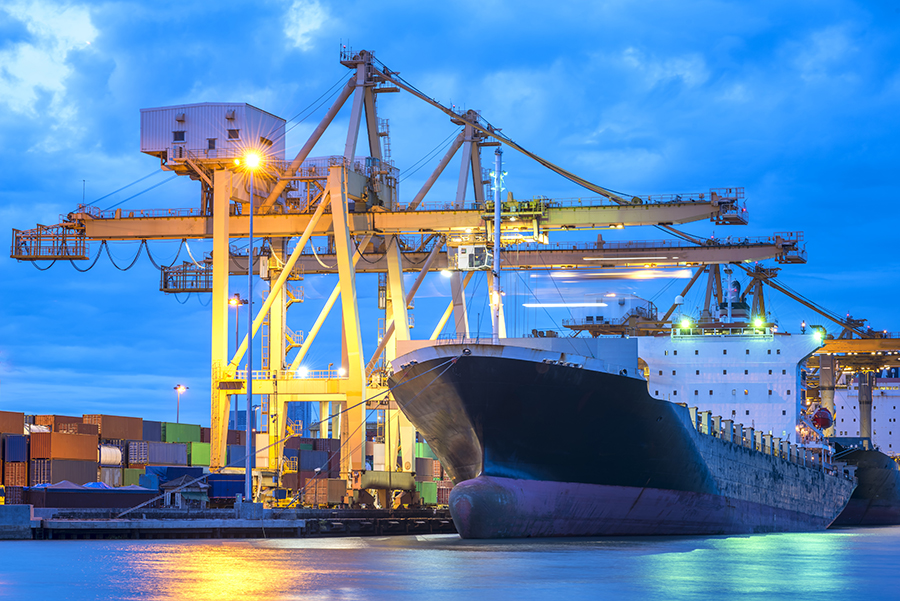Driving Security, Safety & Efficiency at Shipping Ports with Video Analytics

Leverage Video to Drive Port Security & Productivity
Shipping ports are busy, expansive environments bustling with employees, vehicles, trains, cranes and shipping containers that move a great variety of industrial and/or consumer goods in high volumes. The operational staff at the shipping port must be able to track activities across the port’s many offices, terminals, loading docks, customs facilities, and maintenance, storage and parking areas. The stakes are high because of the potential for theft, the risk of accidents, and the labor costs of loading and unloading goods. This is why port operations managers are increasingly adopting technologies that provide real-time, actionable intelligence for extending operational efficiencies and improving security.
In operation 24×7, shipping ports require substantial security staffing. To augment the capacity of security teams, a typical port leverages extensive video surveillance systems to oversee and monitor the area in real time, while also driving archived video review when incidents occur and require investigation. However, given staffing limitations, it is virtually impossible for security teams to actively monitor every camera, or to comprehensively review hours of recorded video footage. Even if they had enough staff to do so, the port authority would still face the challenges of human error and distraction – reasons why many organizations tend not to review video and apply it for practical uses.
Review Video Footage More Quickly and Accurately
To overcome these obstacles and to complement existing video surveillance networks, port authorities can implement video intelligence software, which identifies, classifies and indexes objects in surveillance video footage to make it searchable, actionable and quantifiable. Such software enables operators to search by filtering objects based on their classes and attributes (clothing/vehicle color), including face recognition, appearance similarity, vehicle, person (man, woman, child), and size. It can also detect objects’ speed, paths and their direction, and dwell durations. If a cargo theft occurs, the video analysis software can be used to search and filter footage by criteria and to isolate areas of and objects of interest to focus the investigation.
Automate Real-Time Alerts to Prevent Incidents
The ability to detect, identify, extract and catalog objects in video drives analysis-based alerts triggered by intelligent detection rules. Operators can configure video analytics software to send alerts to security or operations staff when certain objects or behaviors are detected, which might suggest something suspicious or anomalous. For instance, because some areas of a port may have access restrictions or may limit the number of persons permitted to concurrently access the area, operators can set up count-based alerts to make sure that the number of vehicles, people or objects does not exceed the pre-defined threshold. The system will then alert if the detected number of objects exceeds the normal limit.
Alerts can also be used to detect anomalous behavior, such as when a vehicle dwells for a longer duration than a pre-determined threshold. For the sake of safety as well as theft prevention, the movement of people and containers must be carefully tracked, and operators must take note of any unexpectedly high traffic and activity in sensitive areas.
In cases where specific suspicious persons have been identified and in jurisdictions where facial recognition is allowed, port operators can create a “watchlist” of digital images of individuals and trigger alerts when anyone on the watchlist is identified through facial recognition. Real-time face matching enables human operators to quickly respond when alerted to the likely presence of a person-of-interest. Security staff can proactively assess the situations, validate the match and determine the appropriate response, whether continued tracking or intervention, as necessary.
Because facial recognition is not universally legal or productive – such as when camera resolution and placement is ineffective for face detection and matching – a comprehensive video analytics platform is essential. Alongside face recognition, a complete video intelligence solution can trigger real-time alerts based on object classifications and detections, so that security staff can be notified when a person matches a more general description of a suspicious person.
A broader scope of video analysis capabilities also enables users to search video, identify persons of interest and then extract images of unauthorized or suspicious persons from footage. These images can then be utilized to proactively drive future face matching and real-time alerting, and to accelerate post-event video search and investigation moving forward.
Identify Trends to Manage Traffic and Plan Ahead
Because video analytics collects and catalogs data over time, once aggregated and visualized this data can provide operational insights for streamlining port logistics. This quantitative trend data is useful beyond security; for example, users can set up easy-to-read dashboards and visual reports, for tracking the vehicles, people and objects that enter or exit a port. Operators might investigate the average dwell time of a ship in dock, to understand the time it takes for ships to unload, reload and ship out. Or, the users might view a heat map of the port that shows which parts of the port have the most vehicular or shipping traffic; understanding the movement patterns of ships and trucks can help port planners and managers optimize operations or plan future construction.
In these ways and more, video analytics software turns video footage into quantifiable, actionable data. It enables both security and operations staff to leverage their existing video surveillance systems, prevent incidents, respond more quickly to incidents, accelerate post-event investigations, and gain quantitative insights about port traffic and activities – making it a critical driver of safety, security and efficiency for ports around the world.
Signup to receive a monthly blog digest.